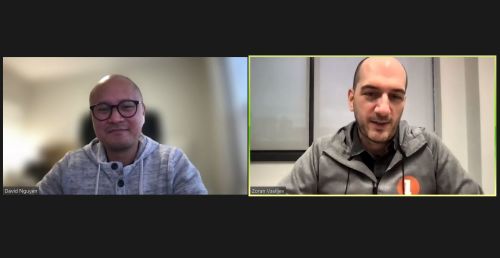author

People Operations Director
published-on
05 Mar 2021
tags
When we introduced the Shifting Gears strategy in 2020, it was clear that a lot of work was ahead of us. Tectonic changes occurred. With the arrival of the new Centili Group CEO Zoran Vasiljev, an avalanche of changes enveloped. We’ve introduced new products, rebranded, and changed our steering direction from a DCB to an MPaaS company. Our internal organisation changed a great deal, with people fluctuating from one department to another, aiming at finding the best way to leave a mark.
We invited Jim Lawless, the author of Taming Tigers and a keynote speaker, to share his experience with us during Centili Anniversary Week. He’s inspired us and gave us a structured approach to personal change. He shared his Taming Tigers Framework, which I found compelling material for translating into the company culture setting.
Check out the video snippet of the webinar.
“We’re born and raised in the industrial age,” says Lawless. Indeed, the industrial age’s desirable values are still ingrained into most people’s minds: show up at the same time, clock in, guess what the boss wants, and try to get it right. However, today’s work requires an approach that transcends these safe boundaries. It requires the minds prone to innovation, the minds that continually challenge the status quo.
“Still, our basic wiring and the perception of how the world works prevents us from acting boldly. We like to play safe,” explains Lawless. As much as this is true in the personal realm, it is right in the organisational environment.
So, what are the mechanisms of change within a company? (Unrelated to business or revenue model innovation -- we talked about that in a separate post.) How do the pursuit of personal change and company reorganisation overlap?
Mechanics of change in a company
Teamwork is the basis of every company. Factors such as company culture, ambition, and processes shape it, making it either a success or an obstacle in the company’s growth.
Teamwork is also the basis for change. Needless to say, every stake holder needs to be on board with the idea of change, and to feel ownership over it. Based on our experience, here are a few essential elements of a successful change at a company level.
An event that triggers the change
Leadership vision
Aligned communication
Dedication
“Change starts with an event.” Jim Lawless states. The pandemic triggered the digital economy’s boom within the industry. In Centili’s case, the event was the pandemic, along with the coinciding change in the leadership, which made us consider leaving our comfort zone and step out from the traditional DCB business. It gave us the push we needed to pivot the new business model. Our big change was entering the payments business and joining the wave of shared economy business solutions with our Monetisation Platform-as-a-Service offer.
The change did not - and cannot occur spontaneously (If it does, it’s usually deterioration, not something to be proud of). The event brought a series of other events and decisions, all of which were bound to make a considerable impact on the regular business.
Another necessary element of an organisational change is leadership vision. Unless the leaders know precisely where they want to go and how to get there, it is impossible to achieve the forces’ alignment and perform the change.
The alignment needs clear communication and ensuring every person at the company is on board with the new vision and strategy. Communication is the grand pillar of every company - and it’s worth exploring every means of successful communication, whether it be tools or processes, to ensure complete transparency and efficiency.
Finally, a change requires dedication from everyone in the company. At Centili, one of our core values is being committed.* The motivation to stay focused stems from the initial event that triggered the change process, which rounds up the entire process.
The Taming Tigers Framework
On an individual level, a change is at a higher stake. “You are human”, Lawless says. You are a big variable with a process. The process fires up when we perceive danger. It’s there to protect us, and it is so powerful that it can change our heartbeat. Within a collective such as the organisation, we are less exposed and enjoy our team’s safety cushion. A change is behavioural, not structural.
At Centili, we pride ourselves on high employee retention. Many of our colleagues have spent 5+ years, some of them even a decade. Changing some processes was not going to be smooth unless we carefully crafted the change process.
“Act as one team” is another of our core values. The idea requires aligned communication, openness, and being appreciative of others’ strengths. As with any other voluminous body, a team has more inertia, requiring a special kind of effort to change. As a People Operations Director, I am aware that the work is delicate and fruitful when done right: our employees’ loyalty and deep connections have proven substantial to endure the changes.
Jim Lawless has devised a rulebook for changing bold and fast. Here are the ten rules he advises to follow.
The Taming Tigers 10 Rules List
Rule 1. Act boldly. Time is limited.
Rule 2. Challenge the rulebook.
Rule 3. Head in the direction of where you want to be every day.
Rule 4. Manage your mind.
Rule 5. The tools for taming tigers are all around you.
Rule 6. There is no safety in numbers.
Rule 7. Do something scary every day: know fear.
Rule 8. Understand and control your time to create change.
Rule 9. Create disciplines - Do the basics brilliantly.
Rule 10. Never, ever give up!
Here are the rules that resonate with a company that goes through a transformation - empirically challenged and confirmed.
Act boldly. The ability to read the market and assess the internal strengths need a final push by the leadership and the boldness to change direction.
Understand and control your time to create change. Lawless gives an example we all can relate to -- our consumption of social media. An hour a day at the end of a year adds up to a full work-week. A successful change on a company level asks for time and effort audit and relocating the energy wisely.
Head in the direction of where you want to be every day. With no exception. Keeping your focus on what matters is necessary for optimising the organisational efforts. Keeping the goals in mind acts like a compass that keeps everyone on the course.
Having the freedom to change - both personally and as an organisation, shows a healthy, mature stage and should be celebrated and supported. We at Centili know that the best!
* Centili’s Five Core Values are: Extraordinary, Committed, Growth-Minded, Humble, and One-Team.
If you want to receive more blog posts to your inbox, don’t forget to sign up for our monthly newsletter below.





